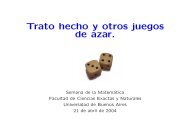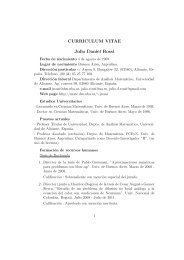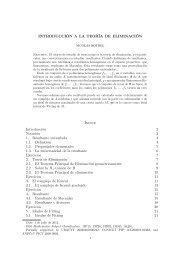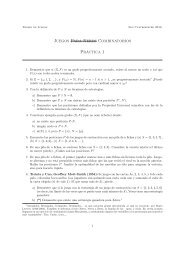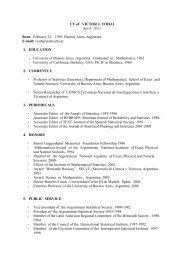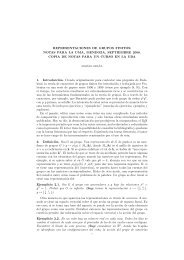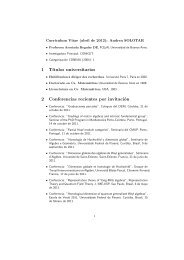You also want an ePaper? Increase the reach of your titles
YUMPU automatically turns print PDFs into web optimized ePapers that Google loves.
se trata de M(x1, . . . , xr) el determinante del menor de las primeras r filas<br />
de la matriz jacobiana. Por lo tanto, si definimos la aplicación<br />
T : Ω 1 RP −→ Ω1 RP<br />
por T (ei) = dfi para i = 1, . . . , r y T (ei) = ei para i ≥ r + 1 tenemos que<br />
T es un isomorfismo. En efecto, basta notar que T −1 = adj(T ) · |T | −1 esta<br />
bien definida. Entonces df1, . . . , dfr es parte de una base de Ω1 RP y (L′ j)P =<br />
Lj(df1, . . . , dfr, Ω1 ). <br />
RP<br />
Corolario 2.70. Sea (R, η) un anillo r.l.e.t.f., I = 〈f1, . . . , fr〉 una icis<br />
entonces para todo primo P tal que JF P el complejo L ′ j localizado en P,<br />
(L ′ j)P , para todo 1 ≤ j < m tiene cohomología cero para todo i = j y es<br />
exacto para todo j ≥ m.<br />
Prueba. Del teorema anterior se sigue que L ′ j es quasi isomorfo a Lj(x1, . . . , xr).<br />
El Corolario 2.45 finaliza la prueba del corolario. <br />
Observación. A continuación presentaremos los ingredientes para poder demostrar<br />
una generalización del Teorema 2.62. Si usamos la notación<br />
el complejo L ′ m+p<br />
<br />
Ω m−1 <br />
1,p+1<br />
dfr<br />
<br />
Ωm <br />
0,p<br />
∂<br />
∂<br />
. ..<br />
dfr<br />
<br />
<br />
. ..<br />
∂<br />
Bl,i−l = Ω ∗ i,l<br />
· · ·<br />
<br />
<br />
. ..<br />
dfr<br />
Ω m−1<br />
<br />
<br />
∂ 1,2<br />
<br />
dfr<br />
<br />
Ωm <br />
0,1<br />
106<br />
∂<br />
∂<br />
∂<br />
· · ·<br />
dfr<br />
<br />
Ω m−2 <br />
2,2<br />
dfr<br />
<br />
Ω m−1 <br />
1,1<br />
dfr<br />
<br />
Ωm <br />
0,0<br />
∂<br />
∂<br />
∂<br />
. . .<br />
. . .<br />
· · · .




